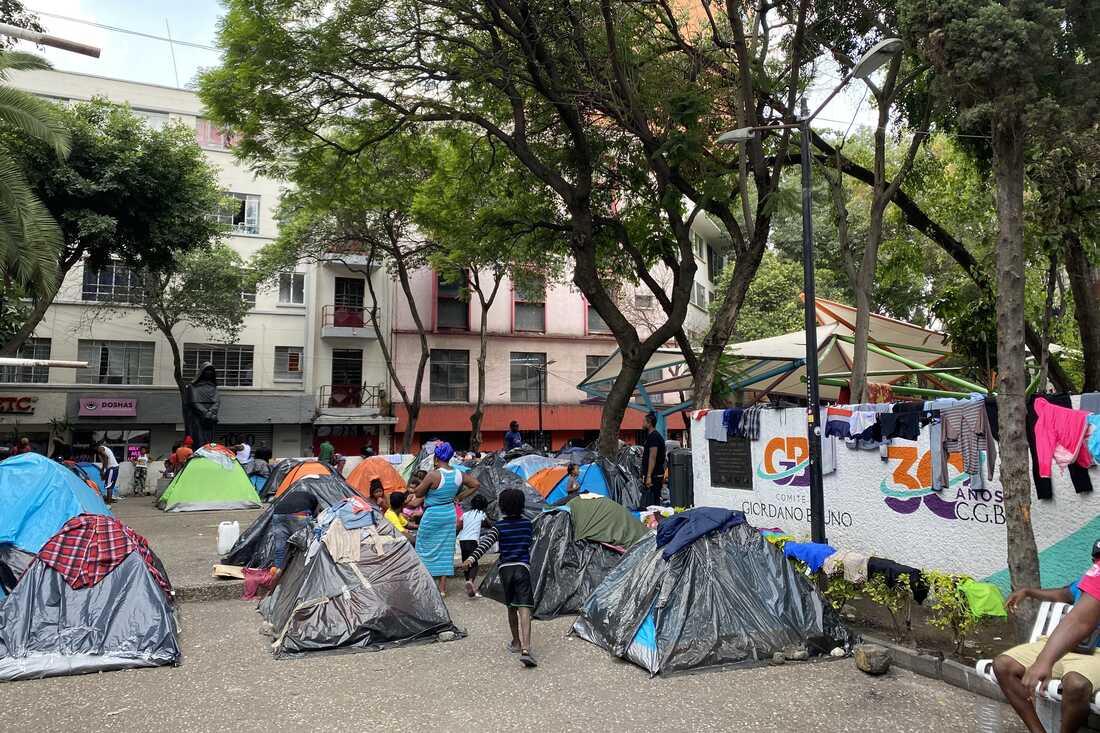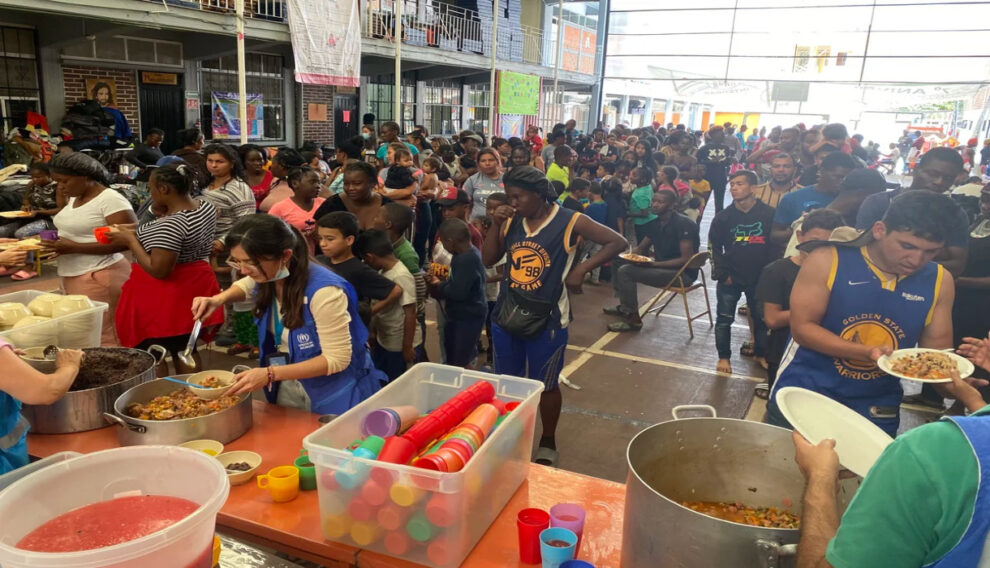MEXICO CITY — There is a refugee shelter in the Mexican capital that is normally known among advocates and migrants as a calm, comfortable place to wait months for asylum. It prioritizes families and people in need of specialized post-traumatic care. Its rows of dormitories look like a budget hotel, where asylum-seekers can make themselves at home in a foreign country.
But on a recent afternoon, the shelter known as CAFEMIN was in chaos.
“It’s an hour wait for the bathroom, you can wait days for a shower,” says 26-year-old Milien Jean from Haiti, here with her husband and 3-year-old son. “Sometimes there’s not enough drinking water.”
The shelter’s 100-person capacity has been stretched above 500 on some nights as it tries to make space for thousands of migrants in limbo in Mexico City. Its covered recreational courtyard is now packed with migrants throughout the day and blanketed with sleeping mats at night.
On May 11, the United States’ pandemic-era policy to turn away most people at the border, Title 42, expired and a new slew of rules left an unknown future for migrants hoping to head to the U.S.
Overcrowding at shelters has long been the norm in Mexico’s northern border cities like Tijuana, Ciudad Juárez and Matamoros. Now, the prolonged uncertainty and confusion for migrants is putting pressure on relief services across Mexico.
“This is extremely painful for me,” says Sister Magdalena Silva, director of CAFEMIN, a nonprofit shelter run by the Roman Catholic community Hermanas Josefinas.
Just a few minutes earlier, the nun had to turn away multiple families with babies. Stays at the shelter are now limited to one week, meaning many will be back to sleeping on the street. “We’re between a rock and a hard place.”
NPR spoke to administrators at four of the five major migrant shelters in Mexico City and each reported being well over capacity in May.
Unlike in the United States where organizations that help resettle refugees receive funding from the federal government, these shelters rely entirely on private donations and U.N. funding.
“At the end of the day, the nonprofit shelters are the only ones doing what we can,” says Sister Magdalena. “There is not the least political will to resolve this humanitarian crisis.”
UNHCR, the U.N. refugee agency, said in a statement it is “concerned about the pressure on nonprofit shelters for refugees and migrants in southern Mexico and Mexico City.” It also said some Venezuelans in shelters were expelled from the U.S. and “do not have information about their legal process and face a lack of reception capacity in Mexico and uncertainty about their legal or migration status.”
More pressure on Mexico’s asylum system
One of the new asylum restrictions implemented by the Biden administration states people must first request asylum in another country and be denied before trying in the U.S. The Mexican government is also receiving up to 1,000 migrants expelled from the U.S. each day. It’s putting pressure on Mexico’s asylum system.
“The United States is transferring responsibility for people to Mexico,” says Melissa Vértiz of the nongovernmental Migration Policy Working Group in Mexico. “But the Mexican government has only received people without necessarily creating the conditions that allow them to stay.”
She says Mexico, in line with existing U.S.-Mexico agreements, prioritizes detention and deportation of migrants instead of integration.
This is clear in Mexico’s federal budget. In 2023, the National Migration Institute, the agency responsible for stopping, detaining and deporting undocumented migrants, has a budget of $90 million, in addition to support from up to 30,000 National Guard troops deployed for migration enforcement. In contrast, the Mexican Commission for Refugee Assistance (COMAR) has a budget of $2.5 million, with an additional $6 million provided by UNHCR.

Hundreds of migrants camp out in a public square a few blocks away from the Mexico City office of refugee agency COMAR. Conditions are particularly difficult as heavy rains have been hitting Mexico City. The camp has been cleared by police and migration agents multiple times but continues to reappear because of a lack of shelter space in the city.
James Fredrick
Mexico’s refugee budget has not kept pace with the rise in asylum-seekers. From January through April, the national refugee assistance commission received 48,970 applications, 35% more than in the same period of 2021, a record year.
Several Mexican government agencies, including the migration authority, did not answer NPR questions about the current situation.
Migrant Camps Emerge in Mexico City
The refugee office in Mexico City is particularly overwhelmed, evident not just in the numbers but on the streets around the office. A line of asylum-seekers stretches down the street every weekday morning. A few blocks away at Plaza Giordano Bruno in the capital’s hip Juárez neighborhood, hundreds of migrants camp in flimsy tents.
“It’s the first time my kids live on the street like this,” says Milouse Xantus, 43, a Haitian mother who’s been camped in the park with her family for two weeks. She visited two nonprofit shelters in the city but both told her they had long waits.
“It’s difficult but there’s no other choice. We have to live like this until God helps us.”
Mexico City’s inclusion and well-being agency has sporadically opened shelters this year after migration agents and police cleared this camp. But it has suddenly shut the same facilities without notifying nonprofits, leading to shelter overcrowding and hundreds of migrants back camping in the plaza.
“We are waiting for documents that will allow us to work,” says Xantus, adding that she was not aware of any city-run shelters. “We’re all waiting for appointments at the refugee office.”
The refugee agency does not provide work permits, but Xantus says migration agents told her to go there for one. The refugee office told her they provide a path to residency through asylum but that if she and her family were approved, they wouldn’t be able to try to go to the United States.
“The government is creating ambiguity and chaos,” says Sister Magdalena from CAFEMIN, noting that Xantus’ confusion is shared by many migrants who enter her shelter.
The CAFEMIN shelter has helped thousands of asylum-seekers resettle and integrate in Mexico since it was founded in 2012. But Sister Magdalena says that work is on hold during their time of crisis.
“We can bear it for now,” she says. “But this is not a long-term solution for all these people.”
Source : NPR News









